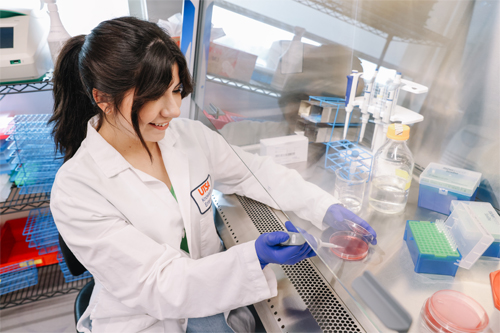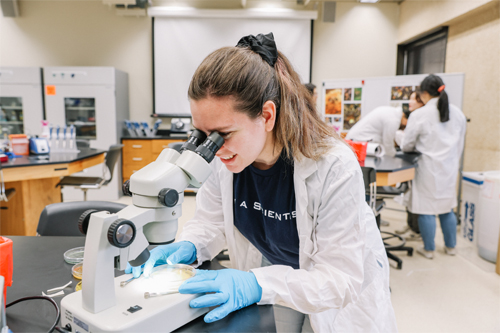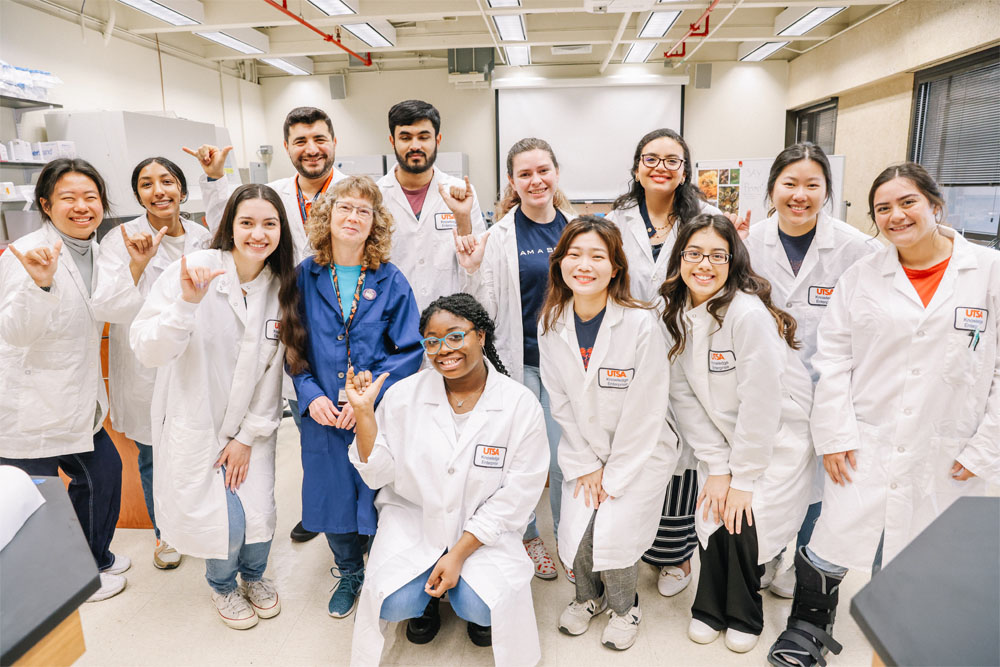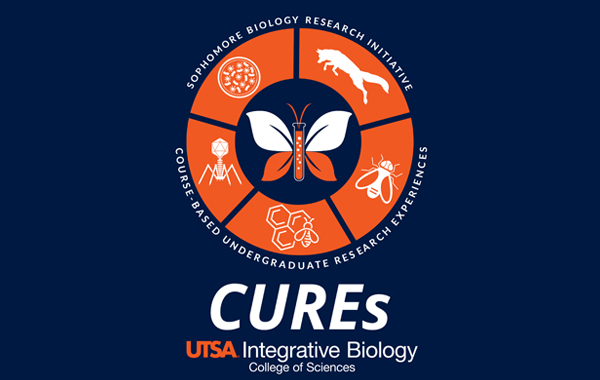BIO 2073 Sophomore Research Experience I (3 cr)
BIO 3053 Sophomore Research Experience II (3 cr)
BIO 3382 Sophomore Research Initiative Peer Mentor (2 cr)
The Sophomore Biology Research Initiative (SBRI) provides course-based undergraduate research experiences (CUREs) for students across a variety of topics aligned with faculty research interests. Students learn to do authentic original research while earning course credit and are offered an opportunity to gain real-world skills while refining their interests and career plans. In particular, these CUREs provide excellent preparation for future positions in faculty labs, graduate/professional school, and other research-based or scientific employment.
Students must enroll in BIO 2073 in the Fall semester and BIO 3053 in the Spring semester and can expect to spend between 4-6 hours total in lectures and/or conducting research each week. In order to progress to BIO 3053, students must receive a grade of C or higher in BIO 2073. BIO 2073 can replace the Molecular Genetics Lab (BIO 2362) in the B.S. Biology degree plan and BIO 3053 can replace the Molecular Biochemistry Lab (BIO 3362) in the B.S. Biology degree plan. Successful students also have the opportunity to return to the program as peer-mentors, receiving up to 4 credits for BIO 3382.
Program Contacts
Dr. Mariah Hopkins, Director of BHE CURE Labs — Mariah.Hopkins@utsa.edu
Donna Degen, CURE Lab Coordinator — Donna.Degen@utsa.edu


In 2024/2025, we will be offering the following CUREs:
HHMI SEA-PHAGES (BIO 2073.A1/AA)
The Howard Hughes Medical Institute (HHMI)'s SEA-PHAGES program. SEA-PHAGES is a two-semester sequence in which students isolate and characterize novel bacteriophages from soil samples. Bacteriophages are viruses that infect and kill bacteria, but have no impact upon animal cells. They have a number of uses to humans ranging from serving as an environmental safety metric to serving as a biotechnological tool to combat antibiotic resistant bacteria. However, while there are approximately 1031 phage particles in the biosphere, only ~3000 have been characterized genomically. Students now have the opportunity to assist in an international effort coordinated by HHMI to find and characterize new bacteriophages. In the first semester ("Phage Discovery"), students will collect soil samples and isolate bacteriophage DNA. In the second semester ("Phage Genomics"), students will analyze their phage's genome using comparative and bioinformatic methods, adding new genomes to a global scientific database.
Microbial Diversity & Antibiotic Discovery (BIO 2073.B1/BA)
Students enrolled in this CURE will explore the diversity of microbes across different habitats and find new sources of antibiotics as part of the Tiny Earth international network of scientists (Tiny Earth—Studentsourcing Antibiotic Discovery). According to the World Health Organization, antibiotic resistant bacteria are one of the greatest threats to human health and food security today. In the U.S. alone, there are more than 2.8 million antibiotic-resistant infections each year, responsible for 35,000 deaths. In this CURE, students will help address this emerging global health threat by characterizing differences in microbial communities in soils at various locations throughout San Antonio and isolating new compounds with possible antibiotic activity produced by these microbes.
Genomics Education Partnership & Fly-CURE (BIO 2073.C1/CA)
The Genomics Education Partnership (GEP) is a nationwide partnership of faculty at over 100 colleges and universities focused on providing underrepresented students with genomics and bioinformatics research experiences. In this CURE, students will learn cutting-edge laboratory techniques and apply new skills in genomics and bioinformatics to build gene models and map genes contributing to mutations in fruit flies. In the Fall, students perform novel gene annotations through the GEP that help scientists understand why there is a discordance in genome size and organismal complexity among Eukaryotes, while others apply network analysis to better understand the insulin-signaling pathway common to animals. In Spring, students participate in the NSF-funded Fly-CURE, using fruit flies as a model to better understand how cancer develops. Opportunities to co-author publications through the GEP may be available to motivated students.
Behavioral Biology of Zoo Animals & Wildlife (BIO 2073.D1/DA)
Students will learn methodological techniques and conduct original research in the fields of bioacoustics and animal behavior, with additional focus on the application of bioinformatics approaches such as machine learning to these fields. Laboratory exercises and research will occur both on-campus and off-campus at sites such as the San Antonio Zoo and local natural areas. Students can expect to conduct independent, original research of value to local stakeholders, while learning hands-on skills and practicing the process of scientific inquiry. Research methods covered include focal and scan sampling techniques for observational research, population census methods, spectrographic analysis of vocalizations, and basic Geographic Information Systems modeling.
Medicinal Properties of Honey (BIO 2073.E1/EA)
This CURE is an on-campus two semester course with some travel within San Antonio and vicinity focusing on the medicinal properties of honey. Honey has been used as a medicine for thousands of years by many civilizations due to its high bioactivity potential. The first aim of this CURE is to acquaint students with honeybees and beekeeping through workshops and interactions with local beekeepers. Students will then conduct original research to identify the bioactivity potential of local honeys through chemical and biological analyses in the lab. Specifically, Biological Activity Levels (BAL) will be determined through quantification of antioxidant and antimicrobial capacity, which includes measurement of total phenolic contents, total flavonoid contents, FRAP, DPPH, and hydrogen peroxide (H2O2) capacity, as well as microplate culturing of bacteria. Using biochemical analytical methods, conformity features such as color, moisture, sugar, enzyme, protein, proline, and HMF profiles will also be characterized.
Recent Program-Related Publications
- Guerrero, J.A., Maldonado, N., Mbajiofor, E.O., Ramirez, L., Valencia, M.J., Healy, C.D., Garza, A.A., Mizell, S.A., Jackson, B.N. and Vargas Ayala, M., 2023. Characterization and genome sequence of Microbacterium foliorum phage Morrigan, of cluster EA6 with siphovirus morphology. Microbiology Resource Announcements, 12(12), pp.e00719-23.
- Nowaskie, R.R., Kitch, A., Adams, A., Anandaraj, A., Apawan, E., Bañuelos, L., Betz, C.J., Bogunia, J.M., Buechlein, N., Burns, M.R. and Collier, H.A., 2023. clifford B. 4.1, an allele of CG1603, causes tissue overgrowth in the Drosophila melanogaster eye. microPublication biology, 2023



